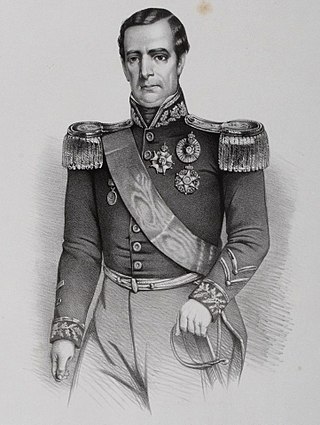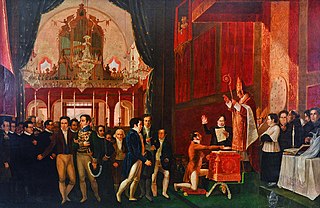The Praieira revolt, also known as the Beach rebellion, was a movement in the Pernambuco province of the Empire of Brazil that lasted from 1848 to 1849. The revolt, influenced by revolutions taking place in Europe, was due in part to unresolved conflicts left over from the Regency period and local resistance to the consolidation of the Empire of Brazil that had been proclaimed in 1822. The movement was led by radical elements of the Liberal Party of Pernambuco against the ruling Conservatives.

The Archdiocese of São Sebastião do Rio de Janeiro in Brazil was established as a territorial prelature on July 19, 1575. It was elevated to the status of a diocese on November 16, 1676. It was later elevated to a metropolitan archdiocese on April 27, 1892. On May 6, 2003, the territorial abbey of Nossa Senhora do Monserrate do Rio de Janeiro lost its territorial rank and was added to the archdiocese. Cardinal Orani João Tempesta OCist has been its Archbishop since 2009. Cardinal Eusébio Scheid SCI, who died on January 13, 2021, was Archbishop Emeritus.

The Confederation of the Equator was a short-lived rebellion that occurred in the northeastern region of the Empire of Brazil in 1824, in the early years of the country's independence from Portugal. The secessionist movement was led by liberals who opposed the authoritarian and centralist policies of the nation's first leader, Emperor Pedro I. The fight occurred in the provinces of Pernambuco, Ceará and Paraíba.

Jaboatão dos Guararapes is a city in the state of Pernambuco, Brazil. It is a part of the Recife metro area. The population was 706,867 according to the Brazilian Institute of Geography and Statistics (IBGE) in 2020, making it the second most-populous city in the state of Pernambuco and the 27th in Brazil, ahead of major Brazilian state capitals such as Cuiabá and Aracaju. The city is a very important industrial center, hosting companies like Unilever and Coca-Cola. It is bordered by Recife in the north, Cabo de Santo Agostinho on the south, and Mangue forests to the west in Moreno.

The Cabanagem was a popular revolution and pro-separatist movement that occurred in the then province of Grão-Pará, Empire of Brazil.

The Metropolitan Archdiocese of Olinda and Recife is a Latin metropolitan archdiocese in northeast Brazil's Pernambuco state.

The Roman Catholic Diocese of Nazaré is located in the city of Nazaré da Mata in the ecclesiastical province of Olinda e Recife in Brazil.

The Roman Catholic Diocese of Pesqueira is a diocese located in the city of Pesqueira in the ecclesiastical province of Olinda e Recife in Brazil.

Pedro de Araújo Lima, Marquis of Olinda was a politician and monarchist of the Empire of Brazil. His long political career spanned the reigns of John VI, Pedro I and Pedro II. He was also one of the founders of the Brazilian Conservative Party.

The Conspiracy of Suaçunas, also known by its archaic spelling, the Conspiracy of Suassuna, was a plot to overthrow Portuguese rule in Brazil at the turn of the 19th century. The conspiracy was centered in Olinda, Brazil.

The Cabanada or War of Cabanos was a rebellion that occurred in the Empire of Brazil between 1832 and 1835. it started shortly after the abdication of Dom Pedro I, during the regency period.

Frei Joaquim do Amor Divino Rabelo, the religious name of Joaquim da Silva Rabelo, commonly known as Frei Caneca, was a Brazilian religious leader, politician, and journalist. He was involved in multiple revolts in Northeastern Brazil during the early 19th century. He acted as the main leader on the Pernambuco Revolt. As a journalist, he founded and edited Typhis Pernambucano, a weekly journal used on the Confederation of the Equator.

Events in the year 1899 in Brazil.

Events in the year 1900 in Brazil.

Events in the year 1966 in Brazil.

The Constituent Cortes of 1820, formal title The General and Extraordinary Cortes of the Portuguese Nation, also frequently known as the Sovereign Congress or the Cortes Constituintes Vintistas, was the first modern Portuguese parliament. Created after the Liberal Revolution of 1820 to prepare a constitution for Portugal and its overseas territories, it used a different system from the traditional General Cortes for choosing representatives, and the three traditional feudal estates no longer sat separately. The Cortes sat between January 24, 1821 and November 4, 1822 at the Palácio das Necessidades in Lisbon. The work of the Constitutional Cortes culminated in the approval of the Portuguese Constitution of 1822.

Francisco de Lima e Silva was a Brazilian military officer and politician who served twice as regent of the Empire of Brazil during the minority of emperor Pedro II.

The regency period is how the decade from 1831 to 1840 became known in the history of the Empire of Brazil, between the abdication of Emperor Pedro I, on 7 April 1831, and the declaration of age of Pedro II, who was legally declared of age by the Senate at the age of 14 on 23 July 1840.

The history from the Brazilian state of Alagoas begins before the discovery of Brazil by the Portuguese, when the territory was inhabited by the Caeté people. The coast of the current state of Alagoas, recognized since the first Portuguese expeditions, was also visited early on by vessels of other nationalities for the barter of brazilwood.

















